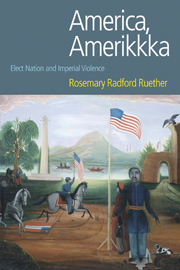Book contents
- Frontmatter
- Dedication
- Contents
- Introduction: THE TWO FACES OF AMERICA: THE IDEAL AMERICA AS DECEPTION AND AS PROTEST
- Chapter One ELECT NATIONS OF EUROPE AND THE MAKING OF THE AMERICAN MYTH OF CHOSENNESS
- Chapter Two THE RIGHTS OF MAN AND THE EXCLUDED OTHERS — THE REVOLUTIONARY ERA AND BEYOND
- Chapter Three MANIFEST DESTINY AND ANGLO-SAXON RACISM — 1815-1875
- Chapter Four MANIFEST DESTINY AND AMERICAN EMPIRE: 1890-1934
- Chapter Five AMERICA'S GLOBAL MISSION: THE COLD WAR ERA, 1945-89
- Chapter Six AMERICAN EMPIRE AND ITS DENOUEMENT: 1990-2007
- Chapter Seven ALTERNATIVE VISIONS OF AMERICA: THE PROTEST TRADITION
- Chapter Eight TOWARD A U.S. THEOLOGY OF LIBERATION AND LETTING GO
- BIBLIOGRAPHY
- INDEX OF BIBLICAL REFERENCES
- GENERAL INDEX
Chapter Four - MANIFEST DESTINY AND AMERICAN EMPIRE: 1890-1934
- Frontmatter
- Dedication
- Contents
- Introduction: THE TWO FACES OF AMERICA: THE IDEAL AMERICA AS DECEPTION AND AS PROTEST
- Chapter One ELECT NATIONS OF EUROPE AND THE MAKING OF THE AMERICAN MYTH OF CHOSENNESS
- Chapter Two THE RIGHTS OF MAN AND THE EXCLUDED OTHERS — THE REVOLUTIONARY ERA AND BEYOND
- Chapter Three MANIFEST DESTINY AND ANGLO-SAXON RACISM — 1815-1875
- Chapter Four MANIFEST DESTINY AND AMERICAN EMPIRE: 1890-1934
- Chapter Five AMERICA'S GLOBAL MISSION: THE COLD WAR ERA, 1945-89
- Chapter Six AMERICAN EMPIRE AND ITS DENOUEMENT: 1990-2007
- Chapter Seven ALTERNATIVE VISIONS OF AMERICA: THE PROTEST TRADITION
- Chapter Eight TOWARD A U.S. THEOLOGY OF LIBERATION AND LETTING GO
- BIBLIOGRAPHY
- INDEX OF BIBLICAL REFERENCES
- GENERAL INDEX
Summary
The last decade of the nineteenth century saw key turning points in a number of trends in American society. The frontier was seen as closing, ending the era of free land to the West. The two excluded peoples, Indigenous Americans and African-Americans, experienced a low point in their mistreatment. The Dawes Act (1887) and the massacre at Wounded Knee (1890) sought to eliminate American Indians as a separate and resistant people to American expansion. The Supreme Court decision Plessy v. Ferguson (1896) confirmed the legality of Jim Crow segregation (see Chapter Two). At the same time immigrants from Eastern and Southern Europe poured into the United States, presenting a new ethnic and religious diversity that was seen as highly unwelcome by those who called themselves ‘native’ Americans; i.e., white Northern European Protestants.
From the 1870s there was rapid urbanization and industrialization. The railroads, electricity, motion pictures, cable cars and petroleum began to transform daily life. Huge fortunes were made by a few, while the vast majority labored long hours in oppressive conditions for just a few dimes an hour. A few hundred men held fortunes of over $1 million, while more than 80 per cent of the U.S. working population made less than $500 a year. Farmers saw a sharp decline in commodity prices, while the high prices charged by railroads and food corporations left them in chronic debt.
- Type
- Chapter
- Information
- America AmerikkkaElect Nation and Imperial Violence, pp. 100 - 135Publisher: Acumen PublishingPrint publication year: 2007



